VOC Testing Methods
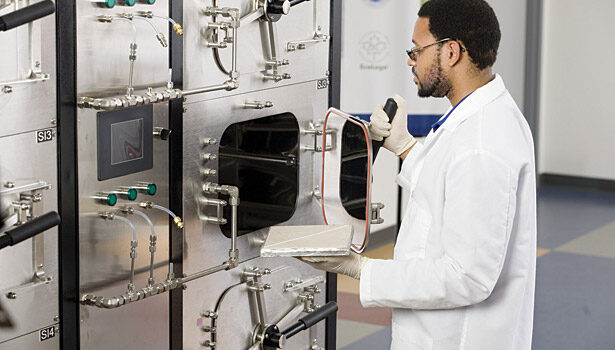
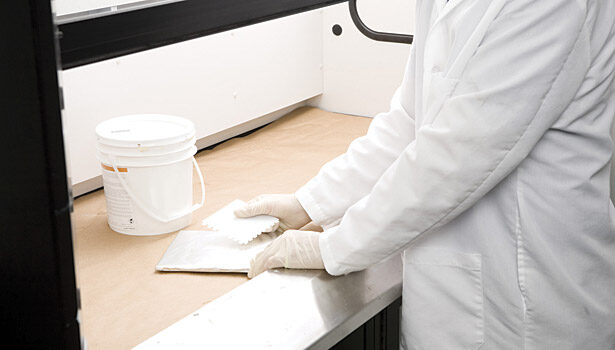
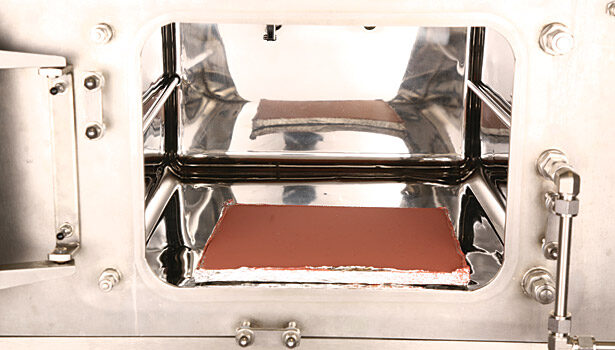
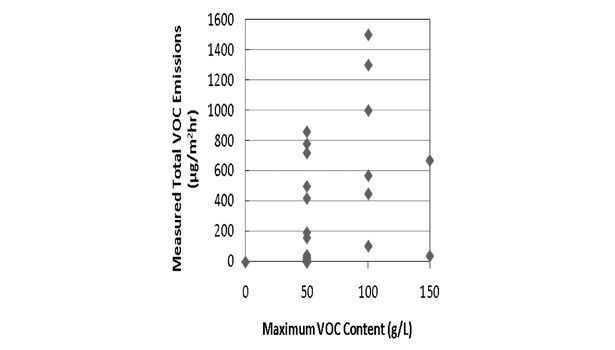
Figure 1. Measured TVOC Emission Factor (µg/m2hr) vs. the Stated Maximum VOC Content Level
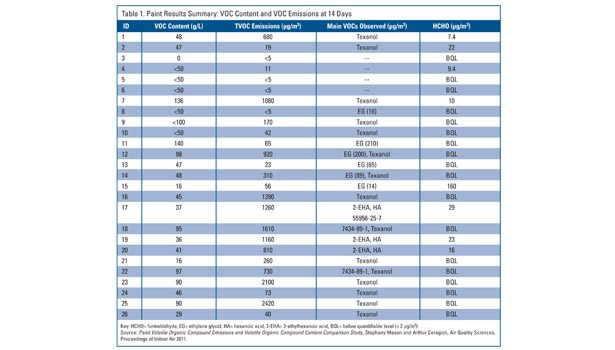





Amid a dizzying array of product performance requirements, standards, regulations, and engineering and cost limitations, manufacturers of adhesives and sealants for interiors must dedicate themselves to formulating high-performance products that are both safe and acceptable to demanding markets. In recent years, volatile organic compound (VOC) emissions have gained increased attention as consumers and green building professionals seek to ensure safe and healthy indoor environments.
Green building programs, construction codes, and government regulations in countries around the world are increasingly demanding low-emitting building products, furnishings, and wet products such as adhesives and sealants. Many of these requirements are new and still evolving, saddling manufacturers with the challenge of keeping track of yet another criterion that must be considered in product formulation, QA testing, and go-to-market strategy.
Limiting VOC emissions is a critical aspect of ensuring that environments are acceptable for human occupants. Demand for low-emitting products is continually on the rise. Adhesive and sealant manufacturers have an opportunity to incorporate VOC emissions criteria into their products as a way to ensure their safety and acceptability for indoor environments, as well as a way to differentiate themselves and reach growing green markets. The starting point is for manufacturers to understand VOC emissions, how emissions differ from VOC content, and what is involved in testing for each.
CONTENT VS. EMISSIONS
Adhesives and sealants manufacturers have long been familiar with the importance of VOCs, which are critical to the performance of their products. VOCs often lend adhesive and sealants the critical attributes to effectively perform their intended purposes. But upon discovering the potential health hazards posed by VOCs, many environmental agencies turned to methods for measuring VOC content as a way to determine their acceptability for use. In Section 183 (e) of the Clean Air Act Amendment of 1990, the Environmental Protection Agency (EPA) proposed measuring paint content in an attempt to minimize detrimental VOC release in the outdoor air. U.S. EPA Method 24 was developed as the standard and measures VOC content based on gravimetric weight loss of a product when heated. VOC content refers to the amount of VOCs in the product formulation.
However, content-based VOC regulations are useful for reducing outdoor VOC emissions that contribute to outdoor air pollution, ozone formation and smog. VOC emissions in indoor environments may expose building occupants to irritating or hazardous chemicals and must be accurately measured at much lower levels. VOC content measurements, usually expressed in grams per liter (g/L), are not useful for measuring or modeling VOC emissions in indoor environments.
A CASE STUDY
To understand the relationship between VOC content and emissions, a study was conducted using paint samples, which are similar in many ways to adhesives and sealants that are also applied wet and left to cure in indoor environments. For this study, scientists used 26 paint and coating products—all with a range of stated VOC content levels from 0-150 g/L, as conforming to the U.S. Green Building Council’s Leadership in Energy and Environmental Design (LEED) NC low-emitting credit criteria for coatings. Samples were tested according to the “Standard Method for Testing and Evaluation of the Volatile Organic Chemical Emissions from Indoor Sources Using Environmental Chambers” (CDPH/EHLB/Standard Method V1.1 (2010)).
The paint was applied to drywall in conditions typical of an indoor environment. Under conditions of carefully controlled temperature and relative humidity, the chamber air was sampled for emissions of total volatile organic compounds (TVOCs), individual volatile organic compounds (IVOCs), formaldehyde and other aldehydes over a 14-day test period.
A summary of results is presented in Table 1. Although all samples are considered low emitting based on a content level from 0-150 g/L, several samples had formaldehyde emission levels above the California Chronic Reference Exposure Level (CREL) of 9 µg/m3. Two samples had ethylene glycol emissions at or above half the CREL (200 µg/m3).
Figure 1 demonstrates the lack of an observed correlation between the measured TVOC emission level and the stated maximum VOC content level. As a result, VOC content should not be used as a proxy for VOC emissions into indoor air. For this reason, an increasing number of green building programs and codes are requiring that dynamic environmental chamber testing be conducted on building products to determine their suitability for indoor environments.
MARKET DEMANDS
A trifecta is driving sustainability: people, planet and profit. The goal of the green building movement is to reduce or eliminate the negative impact of buildings on the environment and on building occupants. Likewise, efforts to reduce waste, increase energy efficiency and improve human health are also money-saving efforts driving profitability.
In the report “Green Outlook 2011: Green Trends Driving Growth,” McGraw-Hill Construction estimates the value of green building construction to be between $43 billion and $54 billion in 2010, and projects that the number will triple or quadruple to between $120 billion and $145 billion by 2015. Consumers, businesses, government agencies and other organizations are all demanding high-performance products that achieve sustainability goals.
A number of voluntary green building programs, such as LEED and the International Green Construction Code (IGCC), as well as mandatory building codes, such as Deutsches Institut für Bautechnik’s (DIBt) Musterbauordnung, are incorporating low-emitting criteria into their requirements. VOC emissions of adhesives and sealants for interiors are addressed in the draft version of LEED 2012, which is undergoing final review and approval. The implementation of the newest requirements will offer adhesives and sealants manufacturers an opportunity to reach new markets and differentiate themselves by proactively testing their products’ VOC emissions.
Currently, some manufacturers have qualified their products as low emitting by testing to current third-party standards and program requirements. Some of these may be found in the publicly available GREENGUARD product guide and a listing provided by CHPS, the national Collaborative High Performance School program.
HELPFUL TIPS
Formulating low-emitting adhesives and sealants is most easily accomplished when considered during the product development and formulation phases. Much like making changes to a building’s blueprint rather than after walls are constructed, it is much easier and less expensive to make changes early in the product development process. At this stage, VOC emissions from raw materials can be tested and accounted for, pinpointing likely problems early and allowing for substitutes to be considered.
However, in many cases, products are already in the marketplace. The following suggested actions can help in these situations.
Conduct Benchmark Testing
Baseline product emissions testing is effective for understanding all VOC emissions and any that are present at potentially hazardous levels. This information allows manufacturers to understand potential problems across the product line and may enable substitutions that help lower VOC emissions across multiple products.
Baseline testing presents a detailed picture of the landscape and indicates key areas where attention may be immediately warranted, helping prioritize efforts. It also identifies certain hazardous VOCs that should be removed from the formulation.
Source Odor Problems
In many cases, odors point to problematic emissions and VOCs. Remedying odor problems involves conducting dynamic environmental chamber testing to identify the chemical source of the odor. Once the source is identified and related to certain raw materials, action can be taken to address the problem by material substitution—simultaneously reducing emissions and improving product acceptability to consumers and building professionals.
Educate Buyers and Users
Off-gassing of adhesives and sealants is particularly high during the application and curing process, so it is important to do everything possible to minimize human exposure during this time. Some of these measures are obvious: apply coatings when the building is unoccupied and will remain so for several days after application, and ventilate the area as much as possible to flush it with fresh air and minimize threats to professionals applying the coatings.
It is important for manufacturers to share these tips with buyers and users of their products. A bit of education can prevent problems and also demonstrate the manufacturer’s awareness of an interest in supporting healthy indoor environments.
Promote Low-Emitting Products
Once a manufacturer has achieved confirmation of a low-emitting product, they should market the achievement with pride. Large and growing green building markets are demanding and, in some cases, requiring these products. Some may even command a premium in the marketplace, helping to defray the expense of additional testing.
AWARENESS IS KEY
Manufacturers must be aware of VOC emissions and how they impact the use and acceptability of their products. For some, formulating low-emitting products will open a window of new business opportunity, and for others, awareness of VOC emissions may be a step toward ensuring the safety of their products. In either case, understanding the issues is a critical first step.
Looking for a reprint of this article?
From high-res PDFs to custom plaques, order your copy today!










